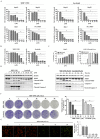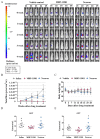MBP-11901 Inhibits Tumor Growth of Hepatocellular Carcinoma through Multitargeted Inhibition of Receptor Tyrosine Kinases
- PMID: 35454900
- PMCID: PMC9030223
- DOI: 10.3390/cancers14081994
MBP-11901 Inhibits Tumor Growth of Hepatocellular Carcinoma through Multitargeted Inhibition of Receptor Tyrosine Kinases
Abstract
Hepatocellular carcinomas (HCCs) are aggressive tumors with a poor prognosis. Approved first-line treatments include sorafenib, lenvatinib, and a combination of atezolizumab and bevacizumab; however, they do not cure HCC. We investigated MBP-11901 as a drug candidate for HCC. Cell proliferation and cytotoxicity were evaluated using normal and cancer human liver cell lines, while Western blotting and flow cytometry evaluated apoptosis. The anticancer effect of MBP-11901 was verified in vitro through migration, invasion, colony formation, and JC-1 MMP assays. In mouse models, the tumor volume, tumor weight, and bodyweight were measured, and cancer cell proliferation and apoptosis were analyzed. The toxicity of MBP-11901 was investigated through GOT/GPT and histological analyses in the liver and kidney. The signaling mechanism of MBP-11901 was investigated through kinase assays, phosphorylation analysis, and in silico docking simulations. Results. MBP-11901 was effective against various human HCC cell lines, leading to the disappearance of most tumors when administered orally in animal models. This effect was dose-dependent, with no differences in efficacy according to administration intervals. MBP-11901 induced anticancer effects by targeting the signaling mechanisms of FLT3, VEGFR2, c-KIT, and PDGFRβ. MBP-11901 is suggested as a novel therapeutic agent for the treatment of advanced or unresectable liver cancer.
Keywords: anticancer agent; complete response; hepatocellular carcinoma; targeted therapy; tyrosine kinase inhibitor.
Conflict of interest statement
The authors have no conflict of interest to disclose.
Figures










Similar articles
-
Novel FLT3/AURK multikinase inhibitor is efficacious against sorafenib-refractory and sorafenib-resistant hepatocellular carcinoma.J Biomed Sci. 2022 Jan 21;29(1):5. doi: 10.1186/s12929-022-00788-0. J Biomed Sci. 2022. PMID: 35062934 Free PMC article.
-
Sorafenib blocks the RAF/MEK/ERK pathway, inhibits tumor angiogenesis, and induces tumor cell apoptosis in hepatocellular carcinoma model PLC/PRF/5.Cancer Res. 2006 Dec 15;66(24):11851-8. doi: 10.1158/0008-5472.CAN-06-1377. Cancer Res. 2006. PMID: 17178882
-
Atezolizumab plus bevacizumab versus sorafenib or atezolizumab alone for unresectable hepatocellular carcinoma: A systematic review.World J Gastrointest Oncol. 2021 Nov 15;13(11):1813-1832. doi: 10.4251/wjgo.v13.i11.1813. World J Gastrointest Oncol. 2021. PMID: 34853653 Free PMC article.
-
Novel approaches for molecular targeted therapy against hepatocellular carcinoma.Hepatol Res. 2018 Jul;48(8):597-607. doi: 10.1111/hepr.13181. Epub 2018 May 17. Hepatol Res. 2018. PMID: 29689631 Review.
-
Hepatocellular Carcinoma: Etiology and Current and Future Drugs.J Clin Exp Hepatol. 2019 Mar-Apr;9(2):221-232. doi: 10.1016/j.jceh.2019.01.004. Epub 2019 Jan 25. J Clin Exp Hepatol. 2019. PMID: 31024205 Free PMC article. Review.
Cited by
-
Suppression of Pathological Ocular Neovascularization by a Small Molecular Multi-Targeting Kinase Inhibitor, DCZ19903.Transl Vis Sci Technol. 2022 Dec 1;11(12):8. doi: 10.1167/tvst.11.12.8. Transl Vis Sci Technol. 2022. PMID: 36484641 Free PMC article.
-
Nuclear respiratory factor 1 regulates super enhancer-controlled SPIDR to protect hepatocellular carcinoma cells from oxidative stress.BMC Gastroenterol. 2024 Mar 4;24(1):97. doi: 10.1186/s12876-024-03183-1. BMC Gastroenterol. 2024. PMID: 38438958 Free PMC article.
-
Efficacy and safety of cinobufacin-based combination therapy for advanced hepatocellular carcinoma: a meta-analysis of randomized controlled trials.Discov Oncol. 2025 May 8;16(1):703. doi: 10.1007/s12672-025-02501-7. Discov Oncol. 2025. PMID: 40342028 Free PMC article.
-
The Comparative Metabolism of a Novel Hepatocellular Carcinoma Therapeutic Agent, 2,3-Diamino-N-(4-(benzo[d]thiazol-2-yl)phenyl)propanamide, in Human and Animal Hepatocytes.Metabolites. 2024 Aug 1;14(8):425. doi: 10.3390/metabo14080425. Metabolites. 2024. PMID: 39195521 Free PMC article.
References
-
- Beaver J.A., Howie L.J., Pelosof L., Kim T., Liu J., Goldberg K.B., Sridhara R., Blumenthal G.M., Farrell A.T., Keegan P. A 25-year experience of US Food and Drug Administration accelerated approval of malignant hematology and oncology drugs and biologics: A review. JAMA Oncol. 2018;4:849–856. doi: 10.1001/jamaoncol.2017.5618. - DOI - PubMed
LinkOut - more resources
Full Text Sources
Medical
Miscellaneous

